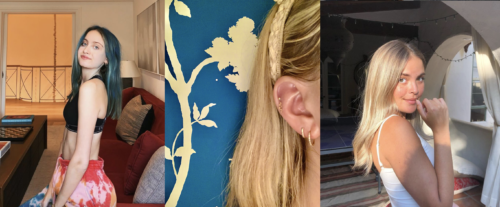You’re staring in the mirror. It’s day infinity of being stuck at home, and your split ends aren’t the only thing that’s dull. Life, it seems, is an endless stream of Zoom classes and news articles.
But look in the mirror—there’s infinite potential for change! You could cut your hair, dye it, pierce your ears, or even tattoo yourself. Experimenting with the canvas of your body could relieve the monotony of any day.
Over the past several months of learning from home, many students have faced moments of self-reflective desperation. What came out of our socially-distanced reality was a rise in body modifications—a quarantine counterculture.
During the peak of stay-at-home orders in the spring, articles with titles like “How to Tattoo Yourself at Home” flooded the internet, while YouTubers uploaded videos on how to highlight one’s hair without a hairdresser, defying the “do not try at home” orders of many chemical bleaches. Copious celebrities have also experimented with their looks during quarantine—Kim Kardashian dyed her hair a fiery red hue, Kaia Gerber bleached her brown hair pink, and Olivia Munn played with blue dye, to name a few.
Evidently, the need for easy, lighthearted ways to spruce up the blur of our days has never been greater.
“During the first few months of quarantine, I suffered from unprecedented boredom as I’m sure many other students did,” explains Anna Wolf ‘23. “So I thought outside of the box. What abnormal activities could I pursue in order to fill my time?”
Wolf decided to purchase temporary blue hair dye on Amazon. The process of applying it stained her hands and the white marble of her bathroom, and her parents weren’t huge fans of her blue hair. Neither was she.
“But dying my hair gave me something to do during my depths of boredom,” Wolf admits. “I’m glad I did it.”

Another student decided to pierce the cartilage of her ears. “I honestly was thinking about it for a while and I guess I felt like I didn’t have time or it was too much of a hassle,” she shares. But in November, she went ahead with the piercing, viewing it as an opportunity to “create some change and break up the monotony of the day and quarantine in general.”
The trend of updating one’s appearance reflects the low-stakes nature of pandemic lockdown. Without having to meet people face-to-face, students have greater freedom to style themselves in new ways.
“I figured that, if it looked bad, at least I wouldn’t have to see anyone,” says Ryan Sanford ‘23, who had never before changed her hair color until this past June. “My goal was to get highlights, but I ended up completely blonde by accident … even though the result was surprising, I’m very happy I dyed my hair,” she shares.
Wolf also expresses the same willingness to change her appearance in a way she never had before. “I wanted to take risks; I had nothing to lose and no one to see,” she explains. “I knew I’d never feel the same way again.”

Other at-home body modifications were born out of necessity. When going to a salon means potentially getting COVID-19, the only other option is to grab some clippers and do the deed yourself.
“I decided to cut my hair myself during quarantine because my split ends were getting really bad and I didn’t want to go to a hairdresser and risk getting infected,” says Annie Colloredo-Mansfeld ‘23. “So I took about one to two inches off myself just looking in the mirror.” The endeavor was successful, she says: “I have trimmed my hair a few times since then!”
Stylistic changes may have also simply felt necessary. With much of the current pandemic situation out of our control, the appeal of changing one of the few things that’s easily changeable right now—one’s appearance—makes sense.
After experiencing a tragic event, some people long for a physical makeover, says Kim Johnson, professor of the social psychology of fashion at the University of Minnesota. “Women who were sexually assaulted often change their appearance after the assault. It’s a renewed sense of control,” she explains. “Applied to coronavirus, the reasoning could be ‘I cannot control the virus, but I can control my appearance.’”
Wolf articulated the unpredictability of her quarantine in the spring: “Life felt too abnormal to me. I had never imagined the world would come to a complete standstill.”
A way to mitigate the abnormality of one’s life, then, is through an unprecedented, uncharacteristic change in appearance.
With COVID-19 vaccines soon to be widely available and the concept of a post-pandemic world now on the horizon, it is unclear how long the counterculture of quarantine will continue. Perhaps whole new beauty trends will emerge. Perhaps the hair dye will wash out just as quickly as it went in.
One thing is certain: experimenting with what you see in the mirror offers a respite from such unforgiving times. Don’t believe me? Grab some dye and try it yourself.
Mary Julia Koch ’23 (@mkoch@college.harvard.edu) writes for the Independent.

